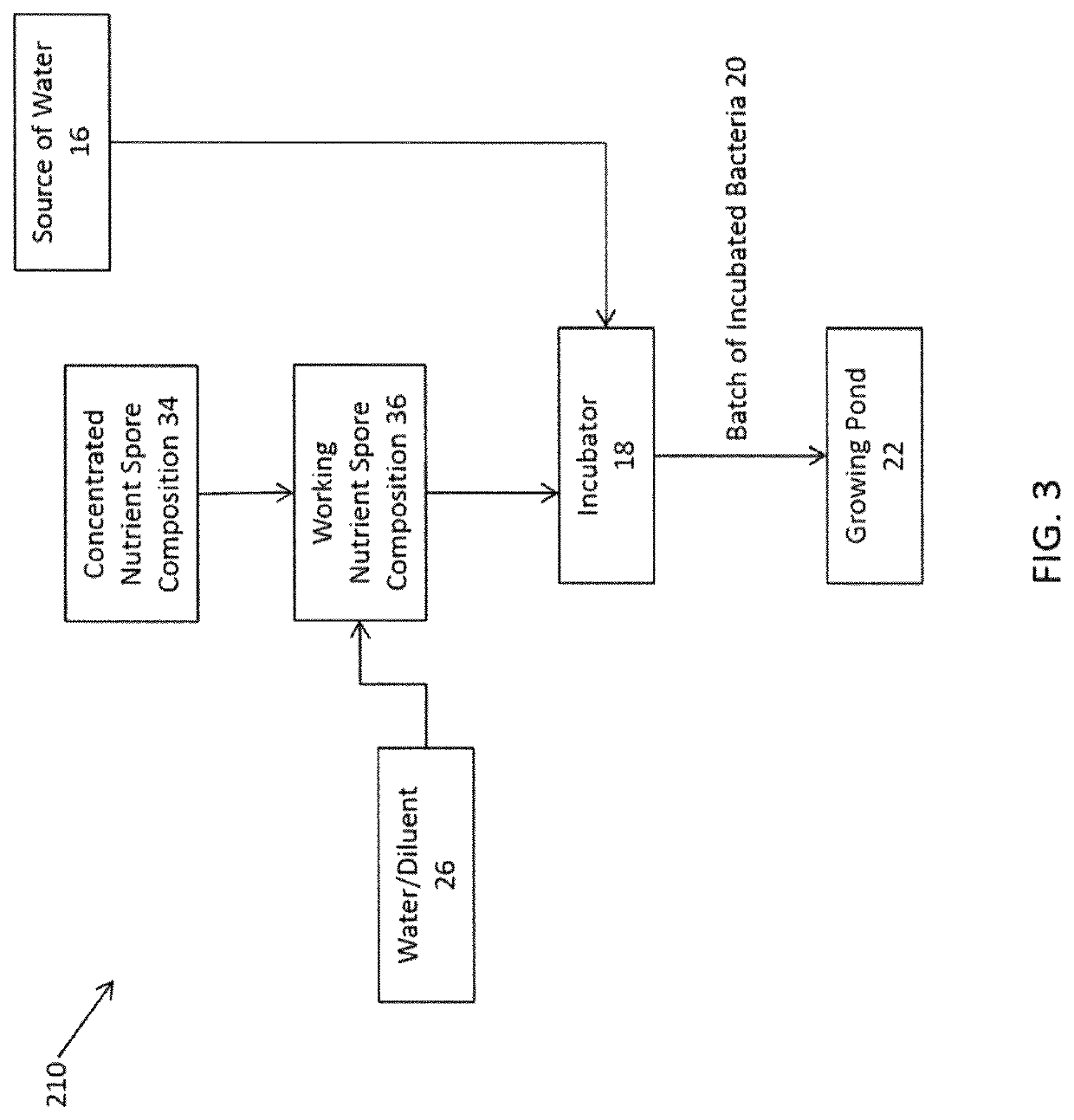Method for improving quality of aquaculture pond water using a nutrient germinant composition and spore incubation method
a technology of nutrient germinant composition and aquaculture pond water, which is applied in the direction of biological water/sewage treatment, water/sludge/sewage treatment, chemistry apparatus and processes, etc., can solve the problems of deteriorating water quality around, loss of products, and increased disease pressure of pathogenic microorganisms in raising facilities, so as to reduce the disease pressure of water livestock and improve the harvesting of species raised. cost-effective
- Summary
- Abstract
- Description
- Claims
- Application Information
AI Technical Summary
Benefits of technology
Problems solved by technology
Method used
Image
Examples
example 1
[0106]To germinate spores, FreeFlow LF-88 Probiotic (spore liquid formula commercially available from NCH Corporation) was added to 1 mL of tap water at a final concentration of approx. 1×109 CFU / mL, where CFU stands for colony forming unit. A nutrient germinant concentrate composition according to a preferred embodiment of the invention comprising L-alanine (89 g / L), monosodium phosphate (20 g / L), disodium phosphate (60 g / L), and Linguard CP (1.6 g / L total) was added to the water and bacteria mixture to provide a 4% final concentration of nutrient-germinant composition by total weight of the mixture. For comparison, negative control reactions were prepared with the same amount of FreeFlow LF-88 Probiotic and water, but without adding the nutrient germinant concentrate composition. Both mixtures (germinant and negative control without the nutrient-germinant composition) were blended and incubated for 60 minutes in a pre-incubated heat block set to 42° C. or at ambient room temperatu...
example 2
[0111]Another set of incubation tests were run using the same test mixture / incubation method (using the same nutrient-germinant composition and heated incubation, “Treated Spores, 42° C.”) and control mixture / incubation method (no nutrient-germinant composition and no heat, “Non-treated Spores, 23° C.”) as described above in Example 1 were repeated, but different tests were run to compare the efficacy of the test mixture according to preferred embodiments of the invention as compared to the control mixture. Additionally, two other mixtures were tested—one in which the nutrient-germinant composition of Example 1 was used but without heat (“Treated Spores, 23° C.”) and one in which no nutrient-germinant was used but the spores were heated (“Non-Treated Spores, 42° C.”). Briefly, spores were incubated at 42° C. or 23° C. for 1 hour with or without treatment with a preferred nutrient-germinant composition. After incubation, the spores from 1 mL of each reaction were pelleted at 14K RPM ...
example 3
[0115]Another set of incubation tests were run using a similar test and control mixture and incubation method as described above in Example 1. Briefly, LF-88 was added to 10 mLs of distilled water at a final concentration of approx. 108 CFU / mL. Samples were incubated at various temperatures to show the efficacy of the test method according to preferred embodiments of the invention as compared to the control mixture. Reactions were prepared with the nutrient-germinant composition described in Example 1 (“Treated spores” in FIG. 9) and incubated at 23° C. (ambient temperature, no heating), 32° C., 42° C., or 60° C. A control reaction was incubated at ambient room temperature with no nutrient-germinant composition. After one hour of incubation, 1 mL of each reaction was pelleted at 14K RPM for 3 min at 23° C. and resuspended in Butterfield's buffer. Approx 6×105 CFUs (0.02 mL) were added to 0.980 mL of Davis minimal media (containing 3% glucose as a carbon source and trace elements) wi...
PUM
| Property | Measurement | Unit |
|---|---|---|
| temperature | aaaaa | aaaaa |
| temperature | aaaaa | aaaaa |
| temperature | aaaaa | aaaaa |
Abstract
Description
Claims
Application Information
 Login to View More
Login to View More - R&D
- Intellectual Property
- Life Sciences
- Materials
- Tech Scout
- Unparalleled Data Quality
- Higher Quality Content
- 60% Fewer Hallucinations
Browse by: Latest US Patents, China's latest patents, Technical Efficacy Thesaurus, Application Domain, Technology Topic, Popular Technical Reports.
© 2025 PatSnap. All rights reserved.Legal|Privacy policy|Modern Slavery Act Transparency Statement|Sitemap|About US| Contact US: help@patsnap.com



